Lang Hancock’s 1979 Queensland-Pilbara Rail-steel Proposal comes to life in 2020.
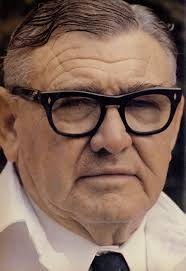
On the morning of Sunday June 11th 1975, passengers aboard Lang Hancock’s 70th Birthday “Wake Up Australia!” jumbo-jet flight will be flying due east from the Pilbara towards Alice Springs over some of the most desolate country in the world. Below them will be the proposed route of the Pilbara-Queensland Railway — the visionary scheme which may within a decade forge a link of steel across the north of Australia. Here Lang Hancock puts a compelling case for a project which can do at least as much for Australia as the Snowy River Scheme; and without soaking the taxpayer.
‘We have our heads well and truly in the sand. How do we dig them out?’
Lang Hancock in 1975.
Now in 2020 Lang Hancock’s dreams are well on their way to becoming reality.
Lang Hancock discovered iron ore in the Pilbara in 1952 and defied the predictions from officialdom that Australia would be importing iron ore by 1965, instead by that time he was supplying half the Japanese market. By 1975 Australia was the biggest exported of iron ore in the world.
Here are a few extracts from a presentation by a man with an extraordinary vision:
‘In 1961 I was told by the so-called doyens of Australia’s mining industry: “Go away and find a deposit on the coast, there are no sizeable ports and no railways in the north-west and none can ever be built in such dreadful blackfellow country.
‘Today there are two ports in the Pilbara with a throughput three times that of Sydney Harbour.
‘In 1962 I was told they had finally condescended to undertake a study to see if it was feasible to build a 1.5-2 million ton per year railway in the Pilbara. I said it needed to be a 10-20 million ton per year railway, to which they replied that I was an impractical dreamer.
‘Today the two bigger railways in the region are each capable of carrying 40 million tons per year.’ Hancock 1975.
The Ruhr of South East Asia
‘This is now 1979 and in view of the above history of events, I would ask you to listen to me now and before discarding my suggestions as impractical, see if you can come up with a better scheme.
Modern technology has made it possible for even small nations to have their own fully integrated steel industry; provided they have the following ingredients:
(a) A cheap source of power;
(b) High-grade iron ore;
(c) Money; and
(d) The resolve to do something.
‘This is the position that could apply to Australia where we have the world’s largest iron ore field on its western side in the Pilbara, and fantastic deposits of coal on its eastern side in Queensland, with the missing link a space of some 1,200 miles (largely flat desert) between the railway system of the Pilbara and that of Central Queensland.
East-West Railway
‘In order to have a second steel complex in Australia we should consider completing the Australian railway system by joining the Pilbara to the Northern Territory gas and the mineral and coalfields of Queensland with its rail system.
‘If this were done it would be possible for a start to put one or two mini steel mills at either end; Ronsard and Townsville — say one or two modules of half a million tons a year each — and bring the coal to the iron ore and the iron ore to the coal, as a basis for enormous secondary industry development.’
‘Hancock 1975’.
Lang Hancock: “The Logic of the Pilbara-Queensland Railway,”
Free Market, vol 1, no 2, June 1979, pp. 21-25.

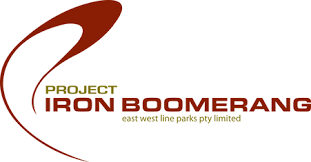 That was forty five years ago. Lang Hancock and the then Premier of Queensland, Joh Bjelke Peterson, had a plan to make Australia a world leader in the manufacture of steel. That it never came to pass is a matter of history and another example of Australia, not Hancock, being frightened to take the big steps forward that have eluded decision makers of all political persuasions and all areas of industry, investment and commerce in Australia since the completion of the Snowy hydro scheme.
That was forty five years ago. Lang Hancock and the then Premier of Queensland, Joh Bjelke Peterson, had a plan to make Australia a world leader in the manufacture of steel. That it never came to pass is a matter of history and another example of Australia, not Hancock, being frightened to take the big steps forward that have eluded decision makers of all political persuasions and all areas of industry, investment and commerce in Australia since the completion of the Snowy hydro scheme.
Mining to me, whether it be coal, iron ore or gas is not Australia building. It has made a few very rich, it has made some of their workers quite rich and it has left Australia without a 21st century infrastructure.
I have written many times that the population of Australia has more than doubled since the Hancock plan was promulgated. During that time we have built a new Canberra every year (+ 100,000 houses for +300,000 people) together with all the infrastructure needed to go with that increase, schools hospitals, water, sewage, public servants (!).
We have not built dams, or a world class base load power supply whether it be coal or gas or nuclear. We cannot wait for battery technology to catch up with needs, it seems electricity is difficult to capture. Our politicians have been and are trapped in the mesh of electoral wind-sniffing and Left-Green influence. Governments move, change with the wind and at the whim of the minority all for the sake of remaining in office and keeping the power office brings. They often lack the intestinal fortitude to defy the wind and the minority and often their own political dogma to make bold decisions for the good of the country. And if they are defied by those forces to take decisions, back to the country. And if the country rejects, then only the country have themselves to blame.
A perfect example of this lack of intestinal fortitude in government is the forecast that New South Wales and Victoria, the two states where lies what is left of our industrial base, could run short of gas within a year or two. This country is the second biggest exporter of gas in the world and we cannot fill our own tanks. Something is seriously wrong. There is a massive amount of gas both under and offshore from both states, yet for some reason, which the electorate will not thank them for, they could all face the ignominy and frustration of power failures when the gas runs out.
 At the same time we have watched our industry move overseas or just close down in the face of competition from countries with whom we signed Free Trade Agreements, and who at the same time had cheaper power and a far lower pay structure than our workers enjoyed. Some of our industry like Holden just disappeared with Australia failing to recognise that almost every motor manufacturer in the world receives some kind of subsidy. Vale Holden.
At the same time we have watched our industry move overseas or just close down in the face of competition from countries with whom we signed Free Trade Agreements, and who at the same time had cheaper power and a far lower pay structure than our workers enjoyed. Some of our industry like Holden just disappeared with Australia failing to recognise that almost every motor manufacturer in the world receives some kind of subsidy. Vale Holden.
Now we export the iron ore and the coal and gas and import our vehicles from those countries to whom China sells steel.
‘Project Iron Boomerang’ needs a strong Federal Government and strong State Governments with both ambition and a belief in the future of Australia.
 I don’t know if it is correct or even fair to call ‘Project Iron Boomerang’ a Phoenix, but that is how it seems to me looking back forty five years; I can remember the buzz that the original proposal caused in Western Australia.
I don’t know if it is correct or even fair to call ‘Project Iron Boomerang’ a Phoenix, but that is how it seems to me looking back forty five years; I can remember the buzz that the original proposal caused in Western Australia.
Now here it is again in 2020, brought forward by entrepreneur and visionary, Shane Condon.

Shane Condon is the Project Founder and Managing Director of East West Line Parks, the holding company of Project Iron Boomerang. The Brisbane-based businessman has worked in the meat and seafood industries as both a Business Operator and Consultant. Mr Condon has recruited a strong team of highly-capable world class professionals and companies committed to delivering Project Iron Boomerang’s business goals and objectives.
The scale of this project is considerable, it has to be world class and a daunting prospect for those all over the world who are in the business of making steel for export, especially China. When this project comes together, as it must for the sake of the future of this country, it will make a major contribution both in the employment of generations to come and to the bottom line of the finances of this country.
What the government in Canberra has to do is look at the dollars this project will generate into the federal coffers to help pay off the debt we are currently incurring because of the pandemic. The current predictions are that it could take thirty years to pay back the money we have, as a nation, borrowed, much of it overseas; that will put my grandchildren in their fifties, so their children will be paying for this pandemic as well, and that is unacceptable.
So what’s in it for us? I always like to start at the bottom line before we consider anything else. What PIB are claiming will happen if/when this project receives the money it needs. These are the dollars that forecast to come back to the country one way and another:
Governments Tax Revenues.
Expected Governments Tax Revenues $21 billion p/a by 2027 if the bankable approval study commences this year by 2018 (Which it now won’t. so that could be 2030? Ed)
Sovereign Governments.
Sovereign Governments are the biggest PIB beneficiaries delivering an expected conservative 30% taxable revenue (from income commercial taxes) on a generated $72 billion p/a at full production rate of 44 m tonnes per year of steel.
Those numbers have to make the Federal Treasure and the Treasurers in Queensland and Western Australia sit straight up in their chairs surely? The big question is how much will it all cost and how long will it take to build?
There is one major step to go — PIB need the imprimatur of the Federal Government, once that is secured then the final stages will be completed.
As far as I can see its a ‘no brainer’ this is just the sort of project that Australia needs to carry the generation to come through twenty first century and beyond. So, wake up Canberra! Wake up Keith Pitt, Minister for Resources.
Total Project Cost.
$55 billion.
The Railway- $16 billion

A rail across Australia from Queensland to the Pilbara in Western Australia. Project Iron Boomerang will build 3, 370 km of heavy standard gauge railway from Moranbah in Queensland to near Newman in Western Australia, at a maximum grade of 1: 200 and a design speed of 80 km/hr.
The forecast is that the rail construction and all the locomotives and rolling stock will will cost $16 billion. There will be 6,000 jobs in the construction phase and 1,500 jobs in permanent operations and rail maintenance.
 The rolling stock have been specially designed with aerodynamic lids to both increase the fuel efficiency of the high capacity locomotives and to eliminate coal and iron dust contamination along the outback route. PIB claim that their aim in everything they do is to adhere to worlds best practice (WBP).
The rolling stock have been specially designed with aerodynamic lids to both increase the fuel efficiency of the high capacity locomotives and to eliminate coal and iron dust contamination along the outback route. PIB claim that their aim in everything they do is to adhere to worlds best practice (WBP).
The rail link will carry limestone and coal from Queensland to Mount Newman in Western Australia, and iron ore going back to Moranba. I didn’t realise until the other day when Shane Condon revealed on his Sky/ YouTube clip that 40% of what is exported in those huge iron ore ships as ore is just Pilbarra soil, dirt call it what you will. What a waste taking that stuff all the way to China .
The business end of the project is what will be built at both ends. This is where ‘Project Iron Boomerang’ gets down to the business end and what an end, a double end it is.
The Steel works- $35 billion.
 Imagine five, yes five of these steel complexes at each end of the rail line. All modular. ‘Build them like a Ford car’ is PIB policy.
Imagine five, yes five of these steel complexes at each end of the rail line. All modular. ‘Build them like a Ford car’ is PIB policy.
They will be modular construction and will share one power plant, coke oven, water and air treatments and stock yard, PIB claim this will save billions of dollars in capital expenditure.
Not satisfied with saving money by going modular PIB are confident that their new steel making complexes will produce 20 to 30 million tonnes per annum less green house gasses than current world’s best practice steel works.
It is forecast that these 10 plants will produce steel worth some $18 billion per year from some 44 million tonnes of steel. That may seem a lot and for some of the sceptics, that may seem too much for the naysayers if there are any, but it is only 2.7% of the worlds current steel production.
Global steel production is some 1,623 tonnes per year. China produces about 50% of that total and uses, internally, some 46% 0f what it produces. Japan and Asia produce about 19%, the EU 10% and the rest is split up between Russia and The Others.
The production for Australia and what it involves in the way of capital expenditure puts PIB into a class seldom seem in Australia, this is probably the biggest investment by an Australian company for many a year. We have welcomed foreign companies with their investment over the years in the development of our gas and mineral resources, and many argue, and they are right, that we wouldn’t be where we are as a nation today without that investment. America is by far and away the biggest investor in Australia.
America’s continuing investment in this country makes Chinese investment pale into insignificance. Australia has a poor record of gathering tax from many major companies both national and international that operate in this country. The balance sheet for Australia would be far healthier if the loopholes could be closed, but that, alas, is just a federal treasurers dream, never to be realised while our taxation laws are so complicated they have become a lawyer’s gravy train.
 ExxonMobil Australia has racked up total income of $42.3 billion over the past five years of available Tax Office data. Yet it paid not one cent in income tax in this country. So American companies do feature in the list of forty that don’t pay the tax it appears they should.
ExxonMobil Australia has racked up total income of $42.3 billion over the past five years of available Tax Office data. Yet it paid not one cent in income tax in this country. So American companies do feature in the list of forty that don’t pay the tax it appears they should.
As of 2017 ‘The cumulative stock of US investment in Australia is currently A$860 billion: That’s A$345 billion more than the next largest investor, the United Kingdom, and approximately ten times more than Chinese investment in Australia. Having represented around a quarter of all foreign direct investment into Australia for over three decades, the stock of US direct investment in Australia is approximately A$195 billion – more than any other country. Critical sources of economic growth, these investments span all sectors of the economy and are responsible for more than 330,000 high-paying jobs with US-affiliated firms in Australia (average salary more than A$115,000), annual capital expenditures of more than A$10 billion, and annual research and development spending of more than A$1 billion since 2009.
Those are impressive numbers and what is more interesting from the perspective of the PIB Project is that investment is two-way, that is Australia is a big investor in America: The US-Australia investment relationship is not a one-way street. The United States has long been the single largest destination of outbound Australian investment, comprising more than a quarter of all Australian overseas investment. Total cumulative Australian investment in the United States is estimated to be A$617 billion – more than seven times the A$87 billion that Australia has invested in China. More than 1,200 Australian firms have operations in the United States, 12 per cent of which have assets or income greater than US$20 million. Australia exports to the United States in 2016 were worth US$9.5 billion – a fraction of the US$60.6 billion that Australian-owned companies made in sales in the same time frame.
What all that means is that there is the money in Australia for investment in big nation changing projects like PIB; at the end of June 2019 there was $2.9 trillion invested in Australian super assets making Australia the 4th largest holder of pension fund assets in the world. It will be interesting to see if the fund managers who control nearly 3 trillion dollars of the workers money are prepared to invest, on behalf of those workers in a project which will help secure Australia’s industrial future.
Building the rail across Australia and five steel making plants in Queensland and another five in Western Australia poses obvious questions:
- Where will the people live?
- How many people will be employed ?
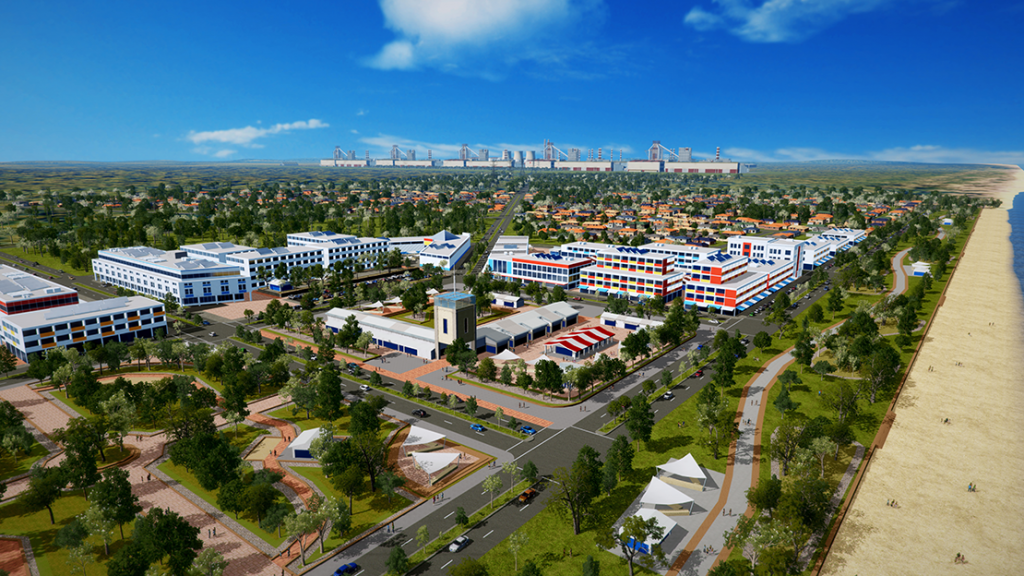 A Brand New Smart City in Queensland another in Western Australia. $4 billion.
A Brand New Smart City in Queensland another in Western Australia. $4 billion.
This is where the numbers start to become really impressive. It is estimated that at the peak of construction of this project some fifty to fifty five thousand will be employed in Australia and another fifteen thousand overseas building the modular steel works.
Once completed a new ‘smart city’ at Bowen will accommodate 20,000 and a smaller facility at Newman another 12,000 with an additional 3,000 in administration split between both facilities.
Water, WATER, WATER and lots of it.
The Bowen ‘new smart city’ will share water treatments and power, there will be a new bio-fuel plant utilizing secondary/tertiary heat and sewage. There will be a twenty five kilometre light rail from the town to the steel works cutting down vehicle traffic by over 5,000 trips a day. There will be a smaller ‘smart city’ built at Newman.
The big question for a project this size is where will the water come from?
This is where this project becomes so innovative:
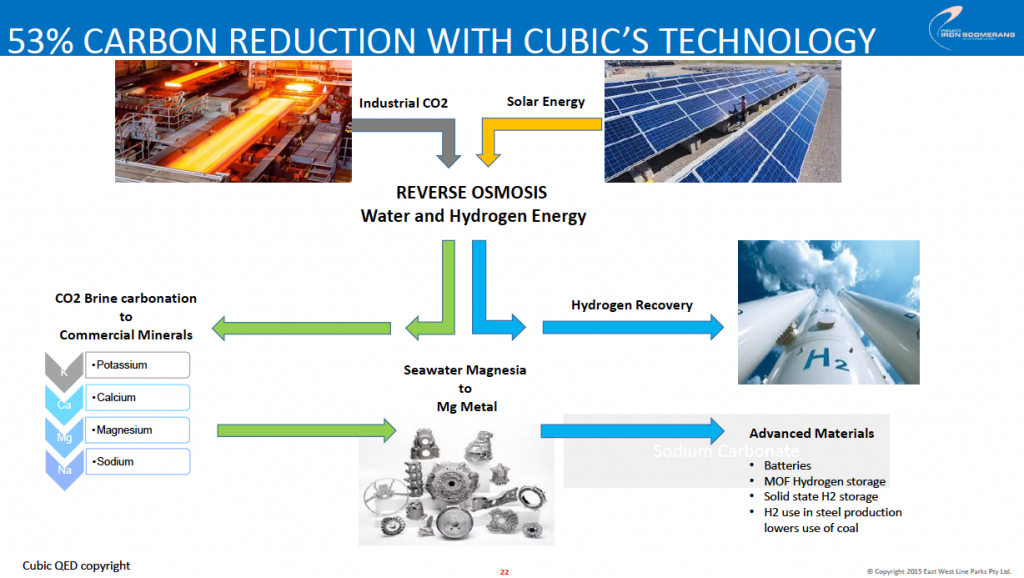
I am not qualified to give a detailed explanation of the diagram above. But what it seems to be indicating is that PIB will obtain all the water it wants, which runs into millions of litres per day for both plants and other uses. It will get the water it needs from the oceans. It will then use renewable energy to desalinate the water. This is the explanation on PIBs presentation:
I hope that helps. This might enlighten the real scientists and calm the Greens?
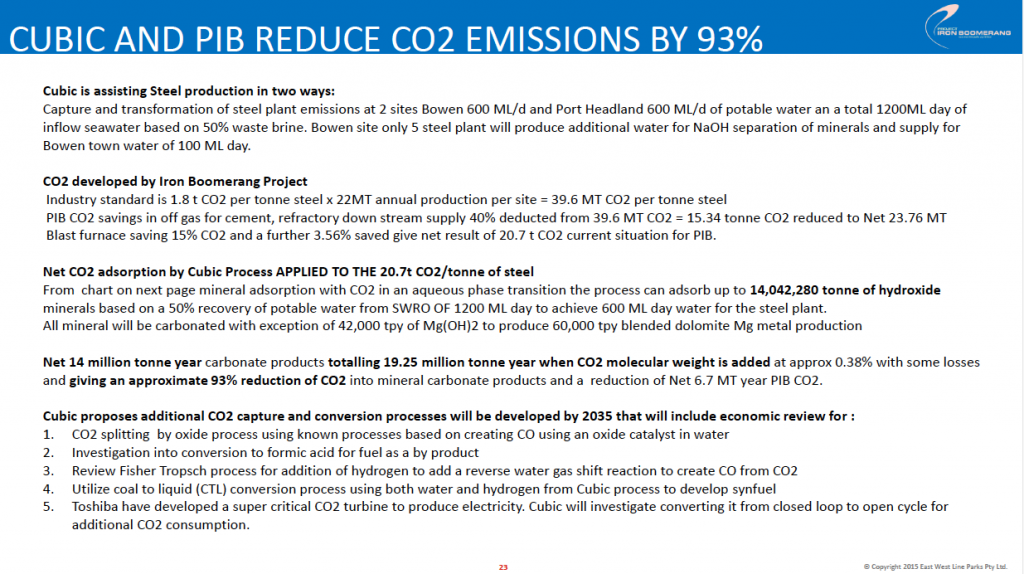 And for those with a real bent for these things, this looks very interesting
And for those with a real bent for these things, this looks very interesting
because it is all part of the biggest steel project this country has ever seen:
 The full story would not be told if I didn’t mention shipping the steel out of Australia and around the world. The plans as far as I can gather is that ships smaller than those that carry the ore will be used. That will enable PIB to cut costs by utilising the Suez and Panama canals and so cutting shipping distance and costs. There are also major savings in shipping costs because 40% or the so-called iron ore that is shipped is just plain Pilbara soil, so there is a big saving there, only steel will be shipped.
The full story would not be told if I didn’t mention shipping the steel out of Australia and around the world. The plans as far as I can gather is that ships smaller than those that carry the ore will be used. That will enable PIB to cut costs by utilising the Suez and Panama canals and so cutting shipping distance and costs. There are also major savings in shipping costs because 40% or the so-called iron ore that is shipped is just plain Pilbara soil, so there is a big saving there, only steel will be shipped.
I hope I have represented PIB as they deserve. It is out of my field but I just believe that it is this kind of project, this kind of industry that is going to drive Australia into the future — a glorious future.

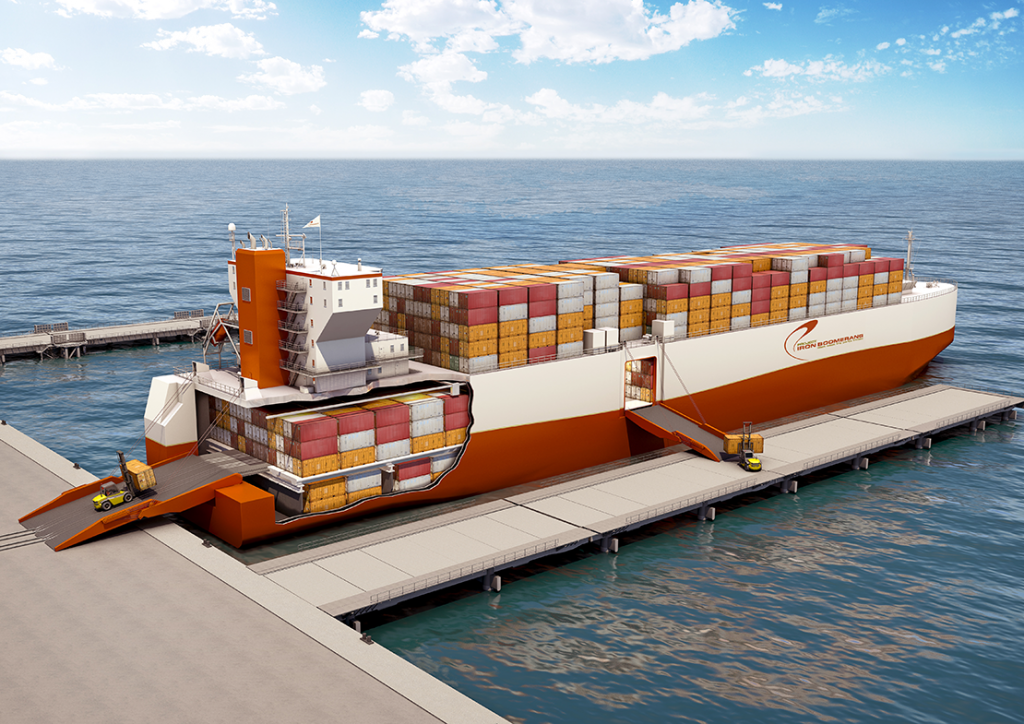
Fantastic Roger! While it is now quite some years since we had regular contact via the old but then very active Agmates site, I have never forgotten you or your wisdom. And now here we are, still above ground in this crazy C21 Covid world! Not bad for a couple of old ICI and Shell Chemical stalwarts.
I will spread this article widely amongst my still highly involved friends.
Best regards
alan mikkelsen
How good is that as the PM would say. hello Alan after all this time. Still writing, have a thrird book out now ‘Bangalore’ labour of love really, quite long, bit of a saga, but satisfying. I have been serialising it in ‘books’ on my site and it is available on ‘print on demand’ from Amazon and a couple of others.
I get to the Global Farmer when I can, Project Iron Boomerang is, as I have written, a no brainer. I hope they get the political support they need. Australia must find its innovative industrial heart again. Stay well.
Roger
This project makes so much sense. It eliminates all those bulk carriers coming back from Asia empty which have a far bigger impact on the environment than was the case with the smaller carriers back in Lang Hancock’s days. So what is holding the project up? Is it financing or a lack of political will by federal and state governments to provide the necessary approvals? I can’t imagine it is financing because money is far cheaper today than it was back in the 1970s and there are plenty of projects as large as this being financed around the world. Is it because Australian politicians can’t think beyond one electoral cycle and can’t contemplate the long term benefits that a project like this would bring to the country?
Your last sentence has it in one!
There is an Inquiry underway into Project Iron Boomerang in the Federal Senate. Please tell everyone so we can garner the support from engineers, farmers, technical professionals and community leaders:
Here is the PARLIAMENT INQUIRY PAGE:
https://www.aph.gov.au/Parliamentary_Business/Committees/Senate/Rural_and_Regional_Affairs_and_Transport/IronBoomerang
Please write a submission addressing the Terms of Reference.
I will do that Glen. I will post it on Facebook as well, which is where I usually update on the Global Farmer. Good Luck with the hearing.
Bravo!
Concentric Industries is ready to privately finance this extraordinary project, and optimize everything in it, from Newman to Abbot Point: 3 Mm of coslZERO®️, steel, and EVERYTHING in between.
Now is the time, for Australia.
For the World.
Let’s DO this!